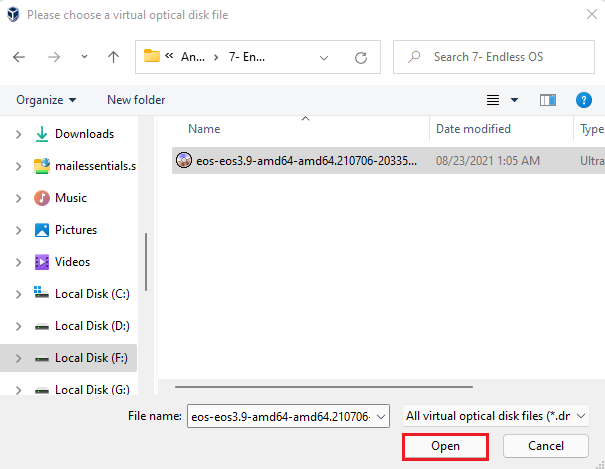

- #VIRTUAL OPTICAL DISK FILE LINUX HOW TO#
- #VIRTUAL OPTICAL DISK FILE LINUX INSTALL#
- #VIRTUAL OPTICAL DISK FILE LINUX SOFTWARE#
- #VIRTUAL OPTICAL DISK FILE LINUX ISO#
- #VIRTUAL OPTICAL DISK FILE LINUX DOWNLOAD#
Virtual box supports 3 VDI, VHD and VMDK.ĭon’t be confuse select first one VDI (VirtualBox Disk Image)Īllocation of storage on physical drive, It may be dynamically or fixed size. There is multiple types of virtual hard disk. You are going to start a fresh, so select second one option. Without hard disk, there is no value of you system anymore, In virtual machine you can create virtual hard disk only. I have 8 GB RAM of my system so I am giving here 2GB. If your computer RAM is more than 4GB then you can give 2 GB. The recommended size is 1 GB, More RAM size means better performance.
#VIRTUAL OPTICAL DISK FILE LINUX ISO#
#VIRTUAL OPTICAL DISK FILE LINUX DOWNLOAD#
Downloading VirtualBox for Windowsĭownload the VirtualBox installer going to its official website at:Ĭlick the Download VirtualBox 6.When you finish installation of virtualbox then you move to next step >ĭownload the latest ISO Image of Ubuntu Operating System form following link. VirtualBox can be useful for other purposes too.

#VIRTUAL OPTICAL DISK FILE LINUX INSTALL#
If you already use Linux, you may want to install VirtualBox to try another distribution. This sequence of posts is devoted mainly to Windows users who haven’t had their first contact with Linux yet and want to try it using the safety of VirtualBox. in the third part, you will see some useful tips for using VirtualBox daily.
#VIRTUAL OPTICAL DISK FILE LINUX HOW TO#

Today we are going to see how to install VirtualBox on Windows, create a virtual machine and boot a Linux live image on it. 20 apps you can use the same way on both Linux and Windows - part 2.We already talked a little about VirtualBox in another post: It can be installed on your PC, whether you use Windows, macOS, Linux or Solaris, and it supports a large number of guest operating systems, including, but not limited to: Windows (3.x, 95, 98, NT, 2000, XP, Server 2003, Vista, 7, 8, 8.1, 10, Server 2008, Server 2012 and Server 2016), DOS, Linux (2.4, 2.6, 3.x and 4.x), Solaris, OpenSolaris, OS/2 and OpenBSD.

#VIRTUAL OPTICAL DISK FILE LINUX SOFTWARE#
VirtualBox is a free and open-source cross-platform virtualization software developed by Oracle. And put simply, VirtualBox is a software that provides you an user-friendly way to do virtualization using your personal computer. This technology is called virtualization. The operating system of the real machine is called host operating system ( host OS): it hosts the virtual machine, whose operating system is called guest operating system ( guest OS). For example, you can use both Windows and Linux at the same time. In practice, that means you can use multiple OSes at the same time. Your computer (which is a physical machine and is, in contrast, called a real machine) can run many virtual machines at the same time (as long as the needed amounts of RAM and disk space are available). The operating system (OS) installed on a virtual machine “believes” it is installed on a “real” computer. It provides similar functionality to a physical machine, so that you can install operating systems and apps on it. But actually that “window”, technically speaking, is a virtual machine (often abbreviated as VM): it is an emulated computer created by software. It is even handier than a LiveDVD/USB, because to use live media you need to reboot.īy “window”, I meant to simplify it, so that you could have a picture of how it looks like. That is handy because you can have your first contact with Linux without actually installing it. VirtualBox allows you to use Linux within a window, just like you use any other app on your familiar operating system.


 0 kommentar(er)
0 kommentar(er)
